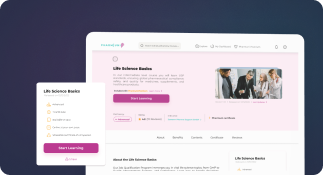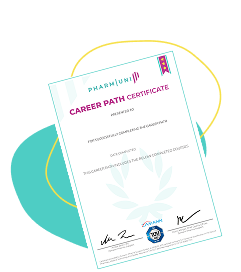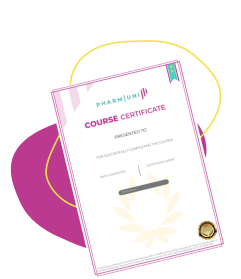A regulatory affairs career path offers stability, growth, and purpose. You become the bridge between innovation and compliance in pharma, biotech, or medical devices. If you’re detail-oriented and love rules that protect lives, this field is your calling. The career path in regulatory affairs gives you both.
Regulatory professionals play a crucial role across the product lifecycle—from research and development to post-market surveillance. They ensure every decision aligns with international standards such as FDA, EMA, or ICH. This job comes with responsibility, but also rewards—job security, global mobility, and constant learning.
So, how do you grow in regulatory affairs? It’s not just about experience. You need a structured learning map with targeted skills, certifications, and milestones. Whether you’re a beginner or already working in quality or R&D, following a clear path saves time, avoids mistakes, and boosts your credibility fast.
That’s where Pharmuni’s Career Paths come in. They offer curated course collections tailored to your role, industry, and ambition. Ready to navigate your next step in regulatory affairs? Let’s break down this journey—step-by-step.
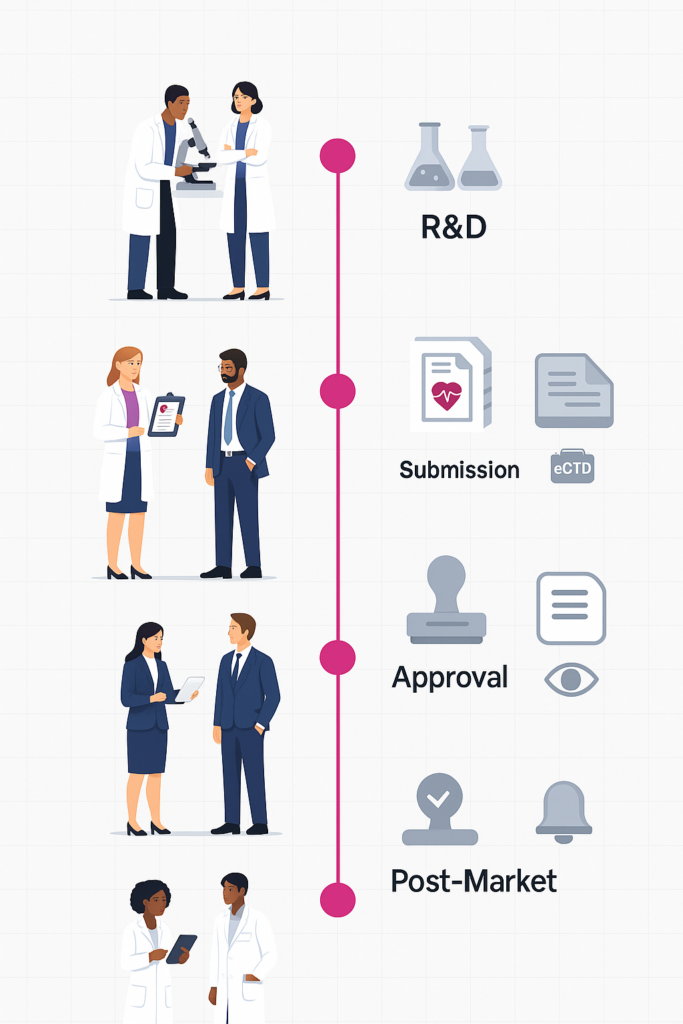
What Is a Regulatory Affairs Career Path?
A regulatory affairs career path is a structured route that helps professionals grow in regulatory roles by following clear stages of learning, responsibility, and certification. It includes both horizontal development (cross-functional skills) and vertical advancement (higher job titles and strategic impact).
In entry-level roles, your focus is usually documentation and submission prep. As you grow, you handle risk assessments, cross-departmental meetings, or global compliance strategy. Each phase requires a different set of technical and soft skills.
Many professionals enter regulatory affairs from quality assurance, research, or project management. But regardless of your starting point, you need to gain knowledge about GMP, ICH, medical device regulations, labeling laws, and regulatory submissions. A strong learning plan, like Pharmuni’s Career Paths, ensures you’re learning the right things at the right time—based on real industry demands.
Key Roles in the Regulatory Affairs Career Path
Understanding the titles helps you plan your next move:
- Regulatory Affairs Associate - Supports regulatory submissions and manages documentation.
- Regulatory Affairs Specialist - Prepares technical files, monitors changes in regulations.
- Regulatory Affairs Manager - Oversees submissions, manages teams, and liaises with health authorities.
- Senior Regulatory Affairs Manager - Develops regulatory strategies and mentors junior staff.
- Regulatory Affairs Director - Leads cross-functional regulatory teams and global filings.
- VP of Regulatory Affairs - Shapes high-level regulatory policy and business compliance goals.
- Consultant or Freelancer - Offers niche expertise to companies on a project basis.
Each step requires certifications, soft skills, and regulatory frameworks mastery. Pharmuni’s learning maps align these stages with practical e-learning courses.
Career Path in Regulatory Affairs: Education and Entry Points
You can start in regulatory affairs from several routes. Many professionals hold degrees in pharmacy, chemistry, biology, biomedical engineering, or related fields. Others move from QA, clinical, or manufacturing. The key is to show attention to detail, clear writing, and process thinking.
Next, you build credibility with targeted courses and certificates. You also gain experience through internships or junior roles. Therefore, you should track your projects and metrics. You can then present impact during interviews. With a focused plan, you enter faster and grow steadily.

Undergraduate and Foundation Stage
Students should build a solid science base. You should also learn documentation, statistics, and ethics. Moreover, you should practice structured writing. Try lab reports with strict templates. This habit will help you follow submission standards later. In parallel, learn the basics of GxP, ISO 13485, and 21 CFR. These rules define how companies design and control products.
Then, add practical exposure. Seek internships in QA or regulatory teams. Volunteer to help with document migration or labeling reviews. Meanwhile, take short courses on dossier structures, labeling, and PMS. These actions prove you can follow SOPs and manage details. They also show you understand how regulations guide daily work. Finally, build a small portfolio. Include templates, checklists, and mock summaries. Recruiters will see your potential clearly.
Early Experience and Certifications
In your first role, expect heavy formatting and summary prep. Coordinating inputs from R&D, QA, and Clinical becomes routine, so timeline discipline matters. Learn version control and change history early, and apply house style with technical precision. At this stage, targeted certifications (e.g., global submissions, labeling, eCTD publishing) strengthen your profile and convert small process wins into measurable results.
At this stage, targeted certification strengthens your profile. Consider short credentials in global submissions, labeling, or vigilance. You can also learn eCTD structure and publishing tools. Furthermore, you should document every improvement you deliver. Did you cut a cycle by two days? Note it. Did you fix a formatting defect? Log it. These metrics will support your next promotion.

Core Skills Checklist
Regulatory Writing
Write clearly and logically. Moreover, use templates and eliminate ambiguity.
Document Control
Track versions and references without errors. Therefore, protect traceability.
Change Control
Evaluate impact and document decisions. Then, coordinate updates across functions.
Cross-Functional Communication
Translate rules for non-experts. Also, ask focused questions to close gaps.
Project Management
Plan timelines and checkpoints. Additionally, escalate risks early.
Dossier Assembly (eCTD)
Structure modules correctly. Next, validate metadata and hyperlinks.
Labeling and Claims
Align claims with evidence. Therefore, collaborate with Medical and Marketing.
Risk Management
Connect hazards to controls. Moreover, document rationales for auditors.
Post-Market Surveillance
Track signals and prepare reports. Then, support CAPA actions.
Agency Interaction
Prepare briefing packages. Also, keep minutes and follow through.
Your Mid-to-Senior Career Map
Mid to senior roles mark a turning point in the career path in regulatory affairs. You move from executing tasks to designing strategy. You lead cross-functional plans and set review rhythms. Moreover, you balance speed with compliance. You convert product goals into clear regulatory roadmaps. Additionally, you coach writers, tighten templates, and raise first-pass yield. Therefore, you prevent last-minute defects and reduce agency queries.
At this level, influence matters as much as expertise. You brief executives, frame trade-offs, and secure resources. Furthermore, you build metrics that prove readiness and guide decisions. You also standardize tools, dashboards, and escalation paths. Then, you cultivate partnerships with authorities and external experts. As a result, submissions move faster and audits run smoother. Finally, you shape culture: you reward evidence, clarity, and accountability. This is leadership in action. Every day.

Manager and Lead Roles
Managers own submission strategy and team performance. By converting product plans into regulatory roadmaps, they align Clinical, QA, and Manufacturing around clear milestones. In addition, realistic schedules and resource models anchor the plan. Readiness dashboards keep leadership informed, and early risk treatment prevents last-minute crises.
Beyond planning, managers mentor junior staff and raise writing quality. Pre-submission checks and coaching reduce agency queries. Refined SOPs and templates cut rework. Meanwhile, cycle time and first-pass yield stay visible on a dashboard; improvements are presented with data. As credibility grows with internal and external partners, approvals speed up and audits run smoother.
Director and Strategic Roles
Directors shape the portfolio view and align regulatory strategy with company goals. In practice, this leadership guides go-to-market decisions and risk appetite. Evidence plans and comparator choices receive senior scrutiny, as do pathway selections such as 510(k), PMA, or accelerated routes. Because each option shifts timelines and budgets, scenario models quantify trade-offs so executives can choose the best-value path.
At this level, senior stakeholders and global agencies expect clarity. Trust grows through crisp logic and clean data. Clear escalation paths and decision rights reduce churn, while targeted digital investments raise transparency. Dashboards track submissions and commitments so delays surface early and the right support mobilizes quickly. Ultimately, regulatory teams operate as strategic partners, not back-office editors.

Common Mistakes and How to Avoid Them
- Overusing Passive Voice: Passive phrases hide ownership. Use active voice to clarify responsibility.
- Ignoring Version Control: Missing links break traceability. Therefore, keep strict naming and logs.
- Late Cross-Functional Reviews: Last-minute edits cause defects. Schedule early checkpoints instead.
- Unclear Rationale: Decisions need reasons. Moreover, auditors expect evidence and context.
- Weak Change Impact Analysis: Surface fixes miss risks. Therefore, assess upstream and downstream effects.
- Neglecting Labeling: Claims misalign without checks. Align with data and regulatory language.
- Under-documenting Meetings: Memories fade fast. Capture minutes and action owners immediately.
- Training Gaps: Teams forget rules over time. Refresh training quarterly with short modules.
- Poor Metric Tracking: Without metrics, you repeat errors. Track cycle time, defects, and queries.
- Not Leveraging Templates: Free-form writing invites variance. Use approved templates to stabilize quality.
Build Your 12-Month Learning Map with Pharmuni’s Career Paths
Start with a clear destination for your career path in regulatory affairs. Define the role, scope, and impact you want within 12 months. Break the year into four quarters with crisp themes. In Q1, master eCTD structure, style rules, and submission hygiene. In Q2, deepen change control, labeling strategy, and claim substantiation. In Q3, practice risk management, CAPA linkage, and meeting minutes that drive action. In Q4, build leadership habits, stakeholder mapping, and escalation paths. Assign one project and one measurable target to each quarter. For example, cut rework by 20% or reduce cycle time by two days. Track baselines, set checkpoints, and review weekly. Therefore, you steer progress instead of hoping for it.
Next, connect learning to visible outcomes. Choose one live product or dossier as your proving ground. Map dependencies, owners, and risks before you start. Then install a simple dashboard to track cycle time, defects, and query rates. Review it with your manager every two weeks and adjust fast. Capture wins in a portfolio with before-and-after evidence and metrics. Also keep a rationale log for key decisions. Finally, use Pharmuni’s Career Paths to pick your next course with precision. As a result, you gain momentum and trust.
Benefits of Pharmuni’s Career Paths:
- First, get a personalized sequence by role and level.
- Next, follow quarter-by-quarter milestones you can track.
- Then, choose course picks mapped to outcomes—not guesswork.
- Additionally, use templates, checklists, and practical examples.
- Meanwhile, monitor your progress dashboard with gentle reminders.
- Furthermore, complete interview-ready portfolio tasks with metrics.
- Also, receive certification prep suggestions (e.g., RAPS).
- In parallel, explore regional pathways for FDA, EMA, and MDR.
- As a result, tackle hands-on projects that prove value fast.
- Finally, view a clear “next step” after every win.
Map Your Regulatory Career in 12 Months
Tools, Templates, and Quick Wins
Submission Readiness Checklist
Prevent missing elements. Moreover, keep owners and due dates visible.
Style Guide and Phrase Bank
Standardize language. Therefore, improve clarity and speed.
Labeling Decision Log
Track evidence and claims. Then, align stakeholders quickly.
Change Impact Matrix
Map upstream and downstream effects. Also, document approvals and dates.
Meeting Minutes Template
Capture decisions in five minutes. Additionally, list action items and owners.
Risk Register
Record hazards, controls, and rationales. Therefore, support audits with confidence.
KPI Dashboard
Monitor cycle time and first-pass yield. Moreover, spotlight bottlenecks early.
Training Tracker
Schedule refreshers and completions. Then, prove compliance during inspections.
eCTD Hyperlink Validator
Catch broken links before publishing. Therefore, prevent resubmissions.
Glossary of Terms
Reduce confusion across teams. Also, onboard new hires faster.
Regions, Products, and Specialization
Regions shape how you build and execute regulatory strategy. The United States, European Union, and other markets follow different pathways, timelines, and evidence rules. Therefore, align dossiers, labeling, and vigilance to local requirements, and plan for variations and renewals. Moreover, map reliance options that can accelerate approvals. Finally, anticipate translation, serialization, and UDI needs before submission.
Products determine the specialization you choose in the career path in regulatory affairs. Pharmaceuticals emphasize clinical evidence, benefit–risk, and lifecycle changes. Meanwhile, medical devices and IVDs focus on design control, risk files, and performance evaluation. Biologics and advanced therapies add CMC depth, comparability, and cold-chain oversight. Consequently, pick a core track and build adjacent fluency. Then, match skills to target markets: evidence planning, labeling strategy, vigilance, and change control.

Pharmaceutical Focus
The career path in regulatory affairs for pharma emphasizes clinical evidence and benefit-risk balance. You will work closely with Clinical and PV. You will also monitor safety signals and labeling updates. Moreover, you will plan variations and manage site changes. You must know ICH guidelines and regional differences. Because timelines and dossier structures vary, you need sharp planning.
To stand out, learn how real-world data supports claims. Understand accelerated pathways and orphan designations. Then, practice mapping evidence to label changes. Additionally, master post-approval commitments and lifecycle management. With these skills, you can guide products from development to mature stages. You will reduce surprises and keep launches on track.
Medical Device and IVD Focus
For devices and IVDs, the career path in regulatory affairs centers on design control and risk management. You collaborate deeply with engineering and quality teams. Moreover, you connect usability studies to labeling and IFUs. You also work with ISO 13485, ISO 14971, and regional rules like EU MDR. Because technical documentation drives approvals, you must keep it complete and current.
To advance, learn unique market pathways such as 510(k), PMA, and IVDR performance evaluation. Then, master UDI requirements and vigilance reporting. Additionally, help teams build clinical and performance evidence when needed. With structured files and strong rationales, you speed up reviews. Therefore, you improve time to market and sustain compliance.
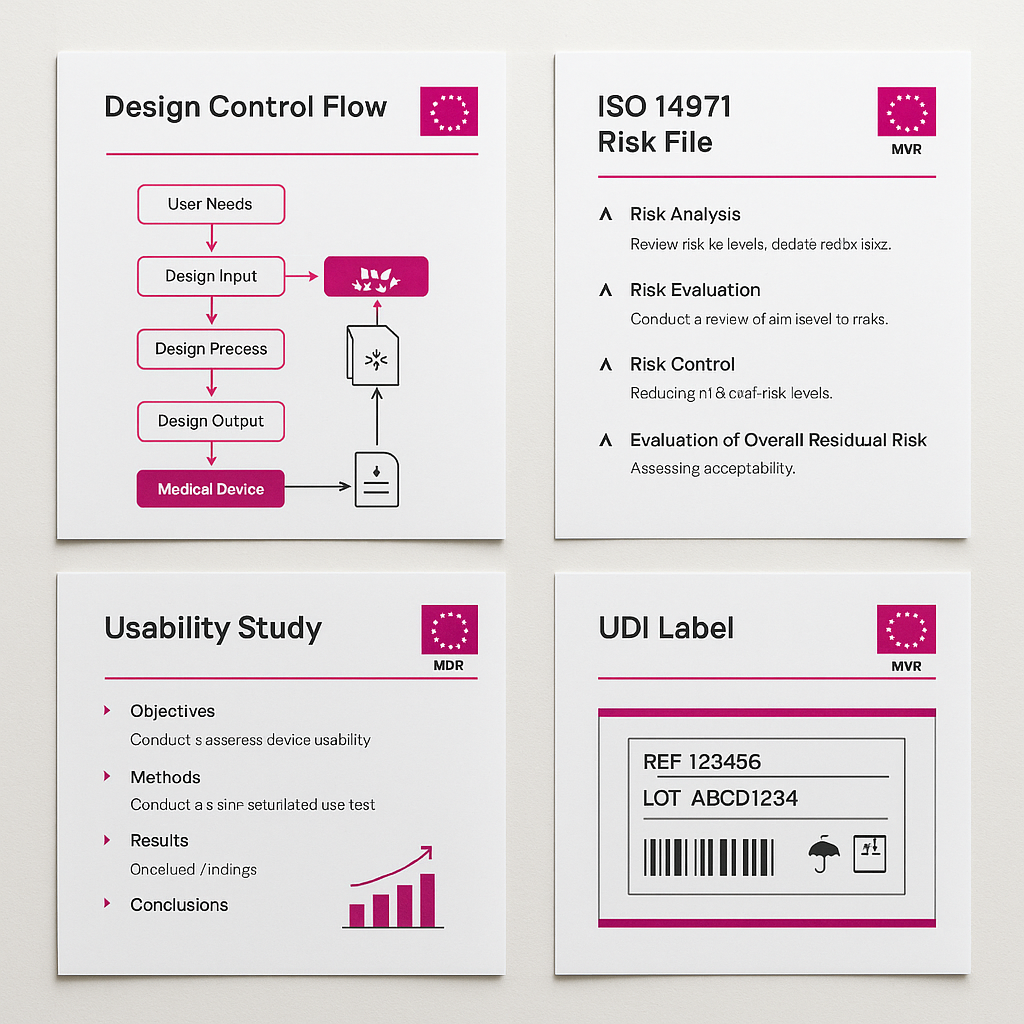
Networking, Mentoring, and Career Branding
Networking, mentoring, and career branding turn skill into opportunity. In the career path in regulatory affairs, relationships open doors that résumés cannot. Start by defining your brand in one line: who you help, how, and where. Then write achievement bullets with metrics for each role. Next, share micro-lessons from checklists, rationales, and audits. These posts show practical value and attract peers. Moreover, ask smart questions in professional forums. You signal curiosity and rigor. Also, document answers and turn them into templates. Finally, build a small portfolio: one template, one rationale log, one before-after improvement. Recruiters remember proof. As your brand grows, mentors appear. You convert guidance into measurable progress.
Key Strategies:
- First, refresh your LinkedIn headline with a clear regulatory value proposition so recruiters grasp your focus.
- Next, add three quantified achievements to each role on your profile to highlight impact.
- Then, post one practical tip weekly from your regulatory toolset; this keeps your expertise visible.
- Additionally, join two niche groups—eCTD publishing and labeling strategy—to learn and connect.
- Meanwhile, ask focused questions during webinars and, afterward, share concise notes to build authority.
- Furthermore, offer a template swap with peers to trade real value and accelerate improvements.
- Likewise, collect testimonials from QA, Clinical, and CMC collaborators to strengthen social proof.
- In parallel, track helpful interactions in a simple CRM or spreadsheet; later, follow up with intent.
- Finally, set a quarterly goal—mentor found, talk delivered, article published—and, consequently, measure progress.
Schedule networking like work in the career path in regulatory affairs. Meet one new contact weekly. Track follow-ups, favors, and insights. Therefore, you build trust steadily and stay visible across projects and markets.
Conclusion
The career path in regulatory affairs rewards clear thinking and steady action. You do not need to guess your next move. Instead, you can follow a simple map. Start with foundation skills and clean writing. Then, learn eCTD, labeling, and change control. Next, practice risk thinking and cross-functional communication. Moreover, build metrics into your work. These numbers prove your impact and accelerate promotions.
As you advance, you will manage strategies and portfolios. You will also influence major decisions with data and logic. Therefore, your career will combine purpose and growth. To move faster, connect your goals to structured learning. Choose focused courses and apply them to real projects. Finally, let a guided path support every step.
References:

Stephanie Männicke
Digital Marketing Especialist at Zamann Pharma Support, brings 8 years of experience in Corporate and Digital Communication. Specializing in Digital Marketing and Content Creation, Stephanie is currently focused on creating strategic content for Pharmuni's networks, especially content on topics such as recruitment, onboarding and employer branding. Outside of work, Stephanie is a mum, a crocheter and a movie fan. An avid reader and in search of expanding her knowledge, Stephanie is always looking for ways to innovate communication in the digital environment and connect people in a genuine way.

Good Manufacturing Practices in Canada: Download Official GMP PDFs (2025)
Want official PDFs for good manufacturing practices in Australia? This page helps you choose and download the right TGA/PIC/S documents fast: PIC/S PE009-17 (Parts I–II + Annexes), plus GMP clearance, inspection reliance, code tables, and the submission user guide for TGA Business Services.

Good Manufacturing Practices (GMP) in Australia 2025: Download TGA GMP Guides
Want official PDFs for good manufacturing practices in Australia? This page helps you choose and download the right TGA/PIC/S documents fast: PIC/S PE009-17 (Parts I–II + Annexes), plus GMP clearance, inspection reliance, code tables, and the submission user guide for TGA Business Services.

GMP Certified Supplements: Meaning and Proof in 2025
In 2026, buyers want proof, not hype. This guide explains what gmp certified supplements mean, what GMP controls in dietary supplement manufacturing, and what GMP does not guarantee. Then it compares GMP claims with third-party programs like USP Verified, NSF, and Informed-Sport. Finally, you get a simple checklist to verify certificates and shop smarter.
